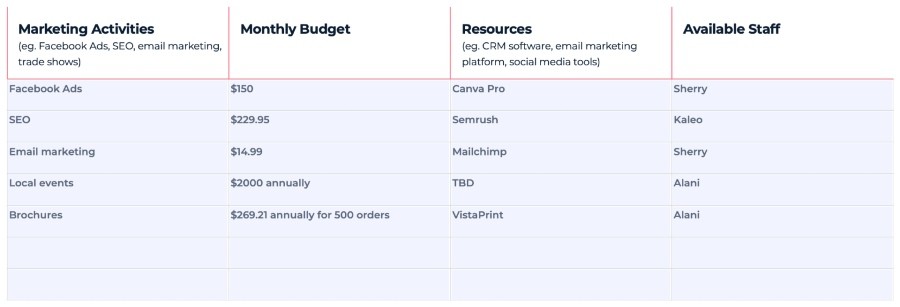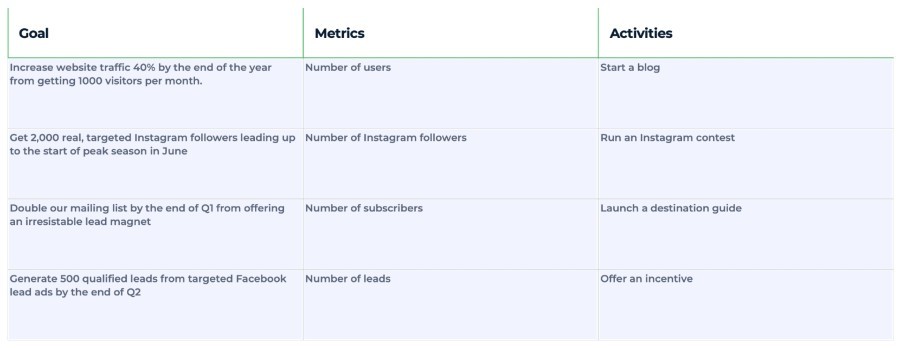You should never leave your marketing up to chance.
Sure, it’s important to be nimble to changing conditions, such as tourism marketing trends, algorithm updates, employee churn, and evolving technology. But if you’re always throwing tactics at the wall to see what sticks, you’ll likely waste resources, fall behind your competitors, and miss out on future opportunities.
Instead, it’s far better to have a well-thought-out marketing strategy in place.
Trial and error can come afterwards.
What is a tourism marketing strategy?
A tourism marketing strategy is a structured document that outlines your current position in the marketplace, what you hope to achieve going forward, and how you’re going to make that happen.
In other words, it provides a framework, so you’re not floundering around, wondering what to do next. All while giving you a way to track your progress so that you can be confident you’re heading in the right direction. And if things change drastically, as we witnessed in 2020, you’ll always have a foundation to build off and make adjustments.
So, are you ready to come up with a master plan? We’ll cover what goes into marketing strategies for travel and tourism, which includes a:
- SWOT Analysis
- Value Proposition
- Guest Personas
- Competitor Profiles
- Marketing Mix
- Budget & Resources
- Goals, Metrics & Activities
- Marketing Roadmap
Follow along by downloading our free 8-Step Marketing Strategy Workbook.
How to write a tourism marketing plan
1. Run a SWOT analysis
A SWOT analysis is a fun exercise that identifies your company’s Strengths, Weaknesses, Opportunities, and Threats.
Strengths and Weaknesses are internal factors that you can control, like your team, resources, and location. In contrast, Opportunities and Threats are external factors that come and go randomly, leaving you with no other choice but to react and adapt — such as travel trends, economic downturns, and your competitor landscape.
To help you with this step, it’s a good idea to round up key members of your team across departments. Why? Because each representative will bring a unique perspective, allowing you to get outside of your business owner bubble. For instance, your tour guides know your guests the best and can offer insight into what they’re thinking and feeling.
Once you have everyone together — in the same room or Zoom meeting — you can start the process. First, answer a few questions that relate to each element.
Like for Strengths, you can ask, “what does our tour company do well?” and “what do guests like about our experiences?” Weaknesses, “what areas of the business need improvement?” and “what do our competitors do better?” As for Opportunities, “is there an underserved market we can tap into?” and Threats, “are there new regulations that impact our business?”
Try to answer at least five questions each, and then summarize what you come up with in a 2×2 SWOT grid for a visual overview.

2. Identify your value proposition
After doing your SWOT Analysis, you should have a general idea of your value proposition — which is a simple statement that answers why someone should book with you instead of your competitors. Essentially, it’s what sets your travel business apart based on the desirable attributes you bring to the experience.
Your value prop is the most important piece in your marketing strategy, as it dictates your messaging and ultimately serves as the first thing guests look at when evaluating your brand with the “what’s in it for me?” mindset. That’s why it should be front and center on your homepage.
But it can be difficult narrowing down all of your unique qualities into one or two sentences. So, your best bet is to compile a list of features and benefits, along with the emotional value for each, and see if there are any obvious patterns.

Looking at the example above, you can see there’s a trend towards a local experience, so the value proposition for this company could be something along the lines of: Experience Hanalei Bay the local way with a paddleboard that looks nothing like a rental.
3. Create a guest persona
If you try to appeal to everyone, you’ll wind up appealing to no one. That’s probably one of the biggest tourism branding mistakes.
Instead, go after 20-35% of people most likely to enjoy your experiences. That way, you can be more effective with your targeting because you’ll understand what makes them tick, or better yet, what makes them book.
How do you go about doing that? Create a guest persona!
What’s a guest persona?
A guest persona is a detailed description of a fictional character that represents your ideal guest. It answers who they are, where they’re from, what matters to them, and where they hang out online.
Thinking of them as a real person before check-in will make it so much easier to craft personalized marketing messages they won’t be able to resist. Plus, you’ll know the best way to reach them. No more unanswered ads!
To create a guest persona:
- Start by combing through your booking data for common demographics like age, gender, geolocation, and language
- Refer to Facebook Audience Insights for psychographics, such as interests and hobbies, lifestyle, and online spending behaviour
- Send out a guest survey to get more details
Then, compile all of your information into a guest persona template with a stock image to put a face to the data. As well as a fun and fictional name — like Solo Travel Sarah, Corporate Catrina, or Vacation Dad Victor.

Now, you might only require one guest persona, but if you offer multiple experiences that appeal to different types of people, like tourism products for senior citizens, it’s best to segment your guests into a few personas seeing as your marketing tactics will change accordingly.
4. Create a competitor profile
The travel industry is tight-knit, so much so that you can even turn your competitors into partners. But that doesn’t mean you can’t still keep tabs on them.
Knowing what your rivals are doing is the best way to gain a competitive edge. Not only does it give you valuable insight into their strengths and weaknesses so that you can see how you stack up, but it also helps you stay one step ahead since you can spot potential threats and opportunities before they happen.
Similar to a guest persona, you can create a profile for your top three competitors, which should include the following marketing information:
- Their value proposition
- The experiences they offer and what they charge
- Who their target audience appears to be
- Unique features and benefits they highlight
- Overall rating on review sites, along with what their guests say about them
- The social media channels they dominate and the type of content they post
- What distribution channels they rely on
- Their domain authority score and top ranking keywords (use a tool like Moz Keyword Explorer to get this information)

It doesn’t stop there. After you’ve built your competitor profiles, you can monitor what they get up to in real-time by:
- Setting up Google Alerts to track mentions of them online
- Following their social media accounts
- And subscribing to their newsletter if they have one
You can always use a fake email address or Instagram account (AKA a Finsta) if you don’t want them to know you’re spying.
5. Develop a tourism marketing mix
A tourism marketing mix is a combination of factors you can control to influence a guest’s decision to book with you. Think of it as a broad guideline for how to market travel and tours so that everything works together seamlessly.
Historically, there are 7ps of tourism marketing, but since tourism operators are unique in the products and services they provide, we’ve stretched it to include eight.
What is a tourism marketing mix?
1. Product
The experiences you offer and what’s included. Take note of everything that would go into the product description, such as duration, itinerary, special features, and other important details.
2. Place
Where people can book your experiences. Traditionally, that would be your ticket office or travel agents, but there are now countless ways people can book — OTAs, email, chatbots, Facebook, your website. Figure out the number one place you want to direct prospects.
3. Price
The price guests will pay based on the perceived value. Factor in what your competitors charge, how much it costs you to provide the experience, your revenue target, and where the market is heading.
4. Promotion
How you’re going to get the word out. Look at what has worked well in the past, where you already have some traction, new social media opportunities, and the best content format for your target audience.
5. People
The people who facilitate the experience. What are the standout qualities your staff has that align with your brand? What skills do your guides have that make the experience memorable, entertaining, and informative?
6. Planning
The measures you take to keep guests in the loop. How do you ensure they show up prepared? How do you tell them about your flexible cancellation policy? Are there any tactics you use to prevent refunds? What if you have to make unwanted changes?
7. Processes
The processes you have in place to guarantee guests get the experience they expect. Everything should run smoothly from the get-go. Consider ways to shorten check-in, stay on schedule, and make them feel valued.
8. Proof
The physical evidence that proves your guests had the best time. This could be in the form of professional photos or merchandise. But it can also be online reviews you encourage them to write on popular platforms.
6. Factor in budget and resources
Everyone wishes they could have marketing clout like the big-name online travel agencies. But the reality is you might never have the same budget and resources to run global campaigns. And that’s okay.
You don’t need deep pockets to make an impact. Thanks to the internet, you can use plenty of cheap marketing ideas to generate buzz around your brand. You just have to channel your creativity.
That said, be sensible with what you take on. For example, if you want to start a blog but don’t have time to commit to a regular publishing schedule, see whether someone on your team has the skills and bandwidth. If not, it isn’t in the cards for you right now.
So, check in with your budget for how much you can reasonably put towards various marketing activities while keeping in mind the software tools and staff you’ll need to execute successfully.

7. Pinpoint goals, metrics, and activities
Now that you know all that you know, give yourself something to work towards by determining what you want to achieve this year and how you’re going to make it happen. We suggest starting with the arbitrary number of four goals and key activities. Why?
Because if you chase too many rabbits at once, you won’t get the results you want. Instead, it’s better to prioritize goals that make sense for your business right now. That way, you can focus on doing a few things well, rather than lots of things badly that’ll only hurt your brand in the long run, which you’ll end up having to fix later anyway.
Goals
When it comes to setting marketing goals, it’s important to be SMART. Don’t just put your finger to the wind and say, “I think we should go this way.” Your goals should be:
- Specific: clearly explains what you want to achieve
- Measurable: has a metric you can objectively measure
- Attainable: something you have to stretch for, but still within your reach
- Realistic: relevant to your business and where you want to go
- Time-bound: when you want to accomplish the goal by
Here’s an example using the SMART method:
Increase organic website traffic 40% by the end of 2021 from getting 1000 visitors per month from Google.
Metrics
How are you going to track your progress? As you can see in the above example, the number of website visitors is the primary metric. Now, many people will tell you to steer clear of vanity metrics — like traffic, followers, and shares — because they don’t directly impact your bottom line.
We couldn’t agree less. Marketing is about the long-game. While those metrics don’t always translate into transactions, they do strengthen brand equity, which in turn drives bookings over time because guests gravitate towards operators with extra oomph online.
The Content Marketing Institute puts it best: think of vanity metrics as optimization metrics. Instead of tying them to ROI, consider their overall value for better understanding your audience on specific channels.
For instance, if a particular social media post generates way more likes than average, it indicates something about that content resonates with your audience. You can pinpoint what that may be and replicate it in future posts or use it as a blueprint for creating effective Facebook ads.
Activities
For each goal you set, figure out one key activity that’ll help you hit it. Don’t be afraid to think big here. By that, I mean, come up with a significant marketing project that you and your team can chip away at — more on that in the next step.

8. Plan your marketing roadmap
After you’ve assigned an activity per goal, break each one down into smaller, manageable tasks to complete from quarter to quarter. Using the example above, let’s say you decide to start a blog as your key activity.
In Q1, you’d get the ball rolling with a few foundation tasks. So, for building a blog, you might start with the following:
- Set up the blog on your website
- Develop a content strategy
- Research topic and keyword opportunities
- Create an editorial calendar
Then, you’d build from there for Q2 and so on.

Try starting with four tasks per activity. Unless you have a marketing team, it’s best not to bog yourself down with a marketing plan that will either a) pull your team away from other responsibilities or b) feel so overwhelming that you abandon it altogether.
With a list of tasks, you can then organize everything onto a visual roadmap however you see fit — just so long as it includes a way to assign staff and track work progress. For instance, you can create a makeshift roadmap if you’re savvy with Google Sheets or use a project management tool like Trello and set-up a kanban board workflow.
Where to go from here?
It’s time to go after it, of course! Just remember that your marketing strategy isn’t set in stone since anything can happen to derail your plans — as we learned the hard way in 2020. So check in with your marketing strategy workbook from time to time to make any necessary adjustments.
Ready to write down your marketing strategy and make it real?

Download the 8-Step Marketing Strategy Workbook
And take command of your brand with a well-thought-out marketing strategy that’s bound to get you results.



